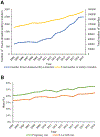Embryo donation: national trends and outcomes, 2004-2019
- PMID: 36368430
- PMCID: PMC9975076
- DOI: 10.1016/j.ajog.2022.10.045
Embryo donation: national trends and outcomes, 2004-2019
Abstract
Background: In 2016, the US Food and Drug Administration amended existing regulations to increase access to donated embryos for reproductive use. Current information regarding the characteristics and outcomes of embryo donation cycles could benefit patients and providers during counseling and decision making.
Objective: This study aimed to examine the trends in the utilization of embryo donation, pregnancy rates, and live birth rates per transfer between 2004 and 2019 and to describe the recipients of donated embryos and outcomes of frozen donated embryo transfer cycles during the most recent time period, that is, 2016 to 2019.
Study design: We conducted a retrospective, population-based cohort study of frozen donated embryo transfer cycles in United States fertility clinics reporting to the National Assisted Reproductive Technology Surveillance System during 2004 to 2019. The trends in the annual number and proportion of frozen donated embryo transfers, pregnancy rates, and live birth rates from 2004 to 2019 were described. During 2016 to 2019, the rates of cycle cancellation, pregnancy, miscarriage, live birth, singleton birth, and good perinatal outcome (delivery ≥37 weeks, birthweight ≥2500 g) of frozen donated embryo transfers were also calculated. Transfer and pregnancy outcomes stratified by oocyte source age at the time of oocyte retrieval were also described.
Results: From 2004 to 2019, there were 21,060 frozen donated embryo transfers in the United States, resulting in 8457 live births. During this period, the annual number and proportion of frozen donated embryo transfers with respect to all transfers increased, as did the pregnancy rate and live birth rate. Among all initiated cycles during 2016 to 2019, the cancellation rate was 8.2%. Among 8773 transfers with known outcomes, 4685 (53.4%) resulted in pregnancy and 3820 (43.5%) in live birth. Among all pregnancies, 814 (17.4%) resulted in miscarriage. Among all live births, 3223 (84.4%) delivered a singleton, of which 2474 (76.8%) had a good perinatal outcome. The clinical pregnancy rate and live birth rate per frozen donated embryo transfer decreased with increasing age of oocyte source.
Conclusion: The outcomes of embryo donation cycles reported in this national cohort may aid patients and providers when considering the use of donated embryos.
Keywords: donor; embryo donation; in vitro fertilization; live birth; miscarriage; outcome.
Copyright © 2022 Elsevier Inc. All rights reserved.
Conflict of interest statement
The authors report no conflict of interest.
Figures

References
-
- Ethics Committee of the American Society for Reproductive Medicine. Electronic address: ASRM@asrm.org, Ethics Committee of the American Society for Reproductive Medicine. Defining embryo donation: an Ethics Committee opinion. Fertil Steril 2016;106:56–8. - PubMed
-
- Lee J, Yap C. Embryo donation: a review. Acta Obstet Gynecol Scand 2003;82:991–6. - PubMed
-
- Finger R, Sommerfelt C, Freeman M, Wilson CK, Wade A, Daly D. A cost-effectiveness comparison of embryo donation with oocyte donation. Fertil Steril 2010;93:379–81. - PubMed
-
- Food and Drug Administration, HHS HHS. Revisions to exceptions applicable to certain human cells, tissues, and cellular and tissue-based products. Final rule. Fed Regist 2016;81:40512–8. - PubMed
MeSH terms
Grants and funding
LinkOut - more resources
Full Text Sources
Medical

